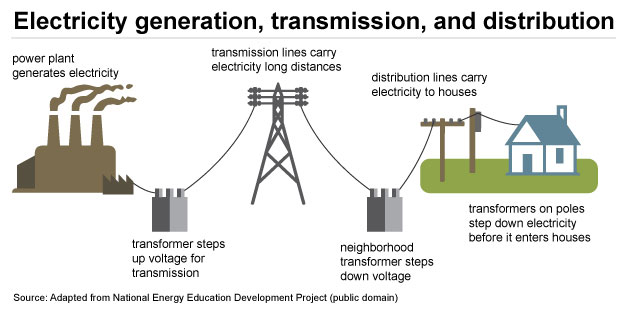When we use electricity at home, we rarely think how it is generated and delivered to us. More importantly, we don't think how electricity supply and delivery affect our ability to use refrigerator or television, or what impact it has on our electric bill. The electricity life-cycle starts with energy generation. The power plant burns coal, gas, oil or some other alternative to produce electricity. It is then transmitted over power lines to homes, offices, factories or other destinations. The sketch below shows the flow of electricity from the origination to consumption.

The utility companies that deliver electricity to customer homes act as middle men. They own transmission lines and are responsible for uninterrupted energy distribution across the grid. When there are power failures, they are the first ones to get involved in troubleshooting outages. The utilities largely do not directly own power plants, but rather buy electricity from the 3rd party generators. In deregulated energy markets that creates an opportunity for residential energy providers to procure electricity to customers. Similar to utility companies, 3rd party providers acquire energy from generation plants, and supply it to the consumers using utility-owned power lines. These alternative companies have a wider range of plans compared to the ones offered by regular utilities. In addition, the alternative energy companies create opportunities not otherwise available from traditional sources, ranging from longer term contracts to green energy options
The electric supply prices charged by utilities are often regulated by state energy agencies. Frequently, local utilities lock shorter term contracts (up to 6 months) with generation plants, allowing them to charge their customers predefined fixed rates. Utilities, like Eversource or United Illuminating of Connecticut change, their prices bi-annually, pre-announcing upcoming rate schedulers about a month before they become active. The price adjustment would still need to receive regulator’s approval, which determines if increase/decrease is justifiable, but once approved, the change will go into effect, and stay fixed for the specified period of time.
New York energy utilities like Con Edison or NYSEG generally do not enter into fixed term contracts with power supply facilities, but rather rely on current market rates to bill their customers. Therefore, supply energy rates charged by utilities vary from month to month. Not surprisingly, residents living in New York State are a lot more exposed to short term electricity fluctuations than the ones of neighboring Connecticut or Massachusetts.
The main advantage of alternative 3rd party energy providers lies in offering longer term fixed power contracts at the prices superior to the ones charged by utilities. While some residents and businesses opt to stay with their local utilities, locking longer term power rates could have a significant advantage. In 2014, when the energy markets spiked, and the average price of electricity raised to 13c per kWh, residents staying with alternative power suppliers realized savings of over 30% relative to the ones billed by local energy companies. Though average savings attained over the term of the contract could not be as extreme as in 2014, they could easily amount to over 15% annually.
While switching to an alternative supplier might not work for everyone, it often offers lower electricity supply costs for longer periods of time, reducing variance of the monthly energy bills. For customers with heavy energy usage, it will translate into significant cost savings.
© PowerSetter.com. All rights reserved.
![]() Green energy choices available
Green energy choices available